check engine light RENAULT KANGOO 2012 X61 / 2.G Owners Manual
[x] Cancel search | Manufacturer: RENAULT, Model Year: 2012, Model line: KANGOO, Model: RENAULT KANGOO 2012 X61 / 2.GPages: 237, PDF Size: 8.62 MB
Page 12 of 237
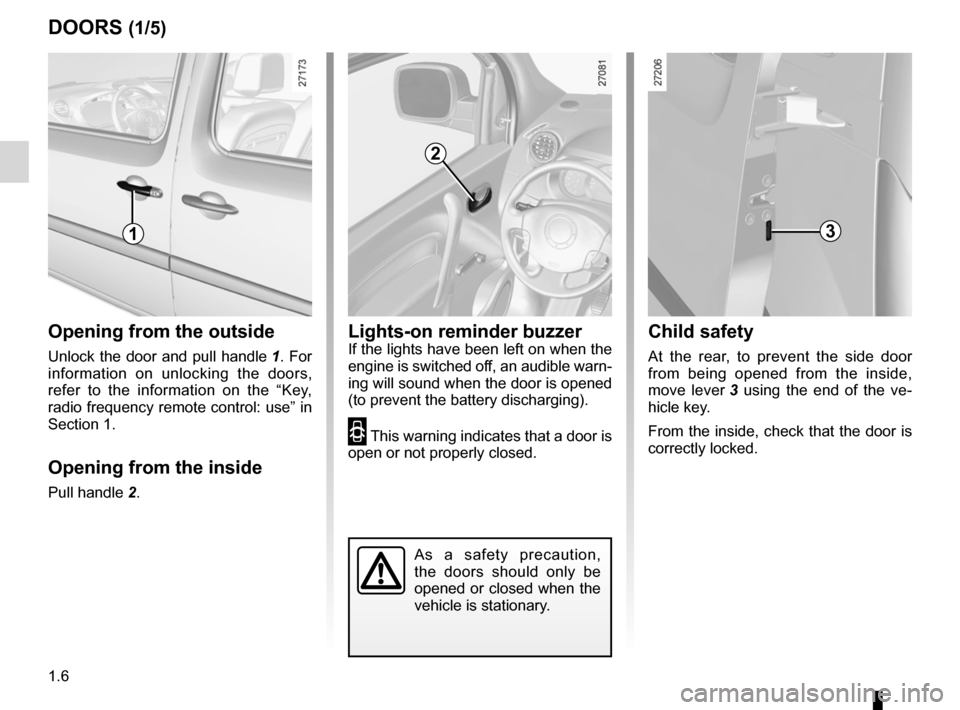
doors..................................................... (up to the end of the DU)
lights-on warning buzzer ........................................ (current page)
closing the doors .................................. (up to the end of the DU)
opening the doors ................................. (up to the end of the DU)
child safety ............................................................. (current page)
1.6
ENG_UD25775_5
Portes (X61 - F61 - K61 - Renault)
ENG_NU_813-11_FK61_Renault_1
Jaune NoirNoir texte
Doors
Opening from the outside
Unlock the door and pull handle 1. For
information on unlocking the doors,
refer to the information on the “Key,
radio frequency remote control: use” in
Section 1.
Opening from the inside
Pull handle 2.
DOORS (1/5)
1
2
Child safety
At the rear, to prevent the side door
from being opened from the inside,
move lever 3 using the end of the ve -
hicle key.
From the inside, check that the door is
correctly locked.
3
Lights-on reminder buzzerIf the lights have been left on when the
engine is switched off, an audible warn-
ing will sound when the door is opened
(to prevent the battery discharging).
2 This warning indicates that a door is
open or not properly closed.
As a safety precaution,
the doors should only be
opened or closed when the
vehicle is stationary.
Page 19 of 237
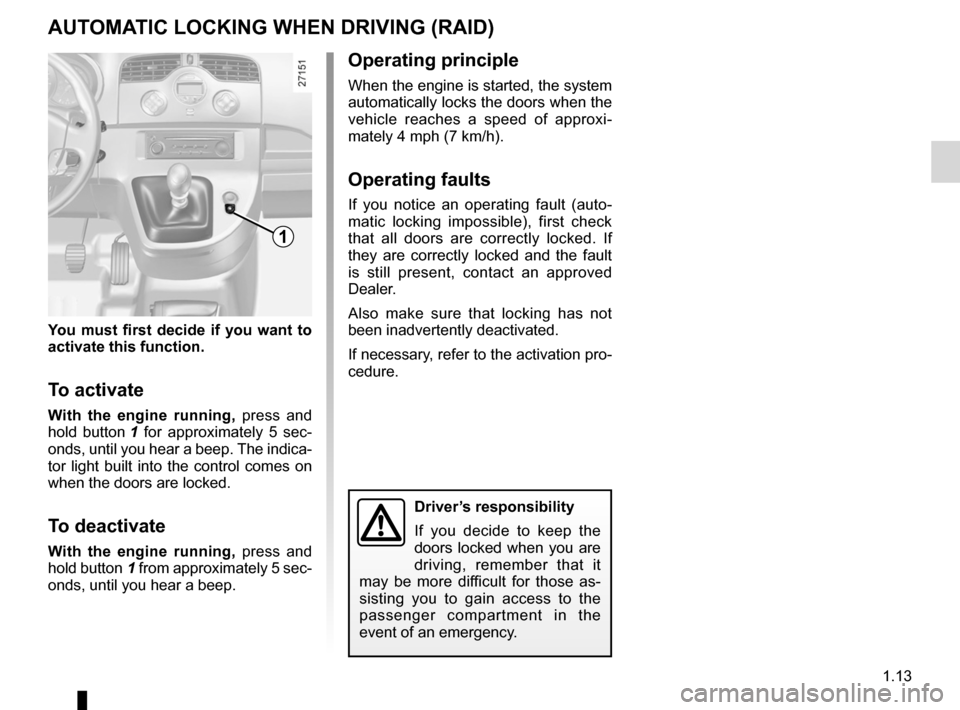
RENAULT ANTI-INTRUDER DEVICE (RAID) .......(current page)
doors ...................................................................... (current page)
1.13
ENG_UD21406_3
Condamnation automatique des ouvrants en roulage (X61 - F61 - K61 - Renault)
ENG_NU_813-11_FK61_Renault_1
y ou must first decide if you want to
activate this function.
To activate
With the engine running, press and
hold button 1 for approximately 5 sec -
onds, until you hear a beep. The indica -
tor light built into the control comes on
when the doors are locked.
To deactivate
With the engine running, press and
hold button 1 from approximately 5 sec-
onds, until you hear a beep.
Automatic locking of opening elements when driving
AUTOMATIC LOCKING WHeN DRIvING (RAID)
Operating principle
When the engine is started, the system
automatically locks the doors when the
vehicle reaches a speed of approxi -
mately 4 mph (7 km/h).
Operating faults
If you notice an operating fault (auto -
matic locking impossible), first check
that all doors are correctly locked. If
they are correctly locked and the fault
is still present, contact an approved
Dealer.
Also make sure that locking has not
been inadvertently deactivated.
If necessary, refer to the activation pro-
cedure.
1
Driver’s responsibility
If you decide to keep the
doors locked when you are
driving, remember that it
may be more difficult for those as -
sisting you to gain access to the
passenger compartment in the
event of an emergency.
Page 32 of 237
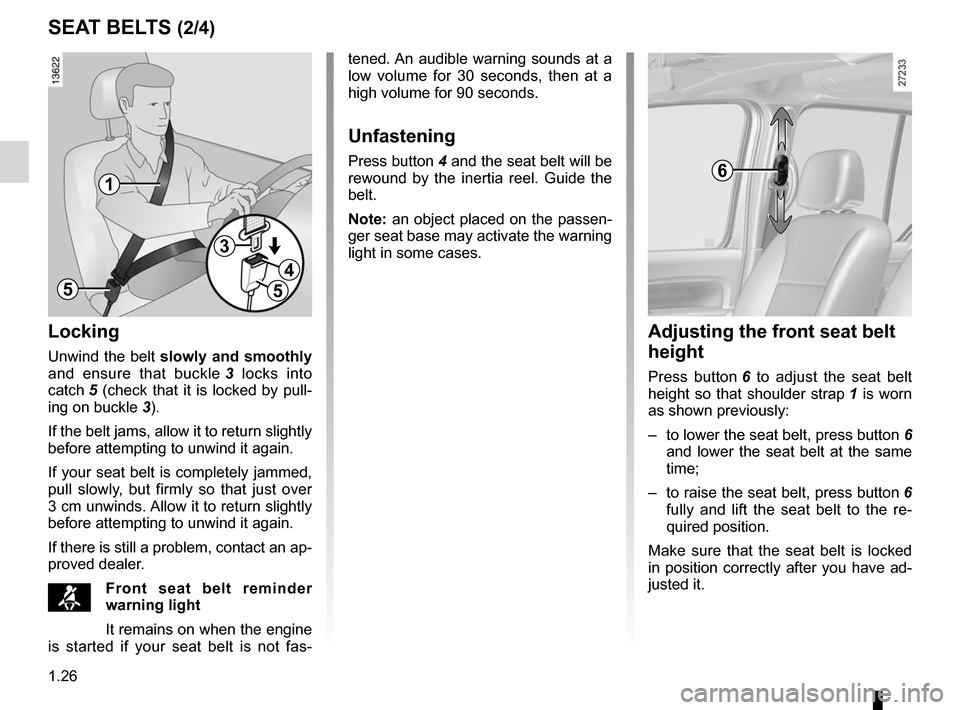
1.26
ENG_UD25776_6
Ceintures de sécurité (X61 - F61 - K61 - Renault)
ENG_NU_813-11_FK61_Renault_1
Jaune NoirNoir texte
SeAT BeLTS (2/4)
tened. An audible warning sounds at a
low volume for 30 seconds, then at a
high volume for 90 seconds.
Unfastening
Press button 4 and the seat belt will be
rewound by the inertia reel. Guide the
belt.
Note: an object placed on the passen-
ger seat base may activate the warning
light in some cases.6
Adjusting the front seat belt
height
Press button 6 to adjust the seat belt
height so that shoulder strap 1 is worn
as shown previously:
– to lower the seat belt, press button 6
and lower the seat belt at the same
time;
– to raise the seat belt, press button 6
fully and lift the seat belt to the re -
quired position.
Make sure that the seat belt is locked
in position correctly after you have ad-
justed it.
Locking
Unwind the belt slowly and smoothly
and ensure that buckle 3 locks into
catch 5 (check that it is locked by pull -
ing on buckle 3).
If the belt jams, allow it to return slightly
before attempting to unwind it again.
If your seat belt is completely jammed,
pull slowly, but firmly so that just over
3 cm unwinds. Allow it to return slightly
before attempting to unwind it again.
If there is still a problem, contact an ap-
proved dealer.
™Front seat belt reminder
warning light
It remains on when the engine
is started if your seat belt is not fas -
1
5
3
4
5
Page 39 of 237
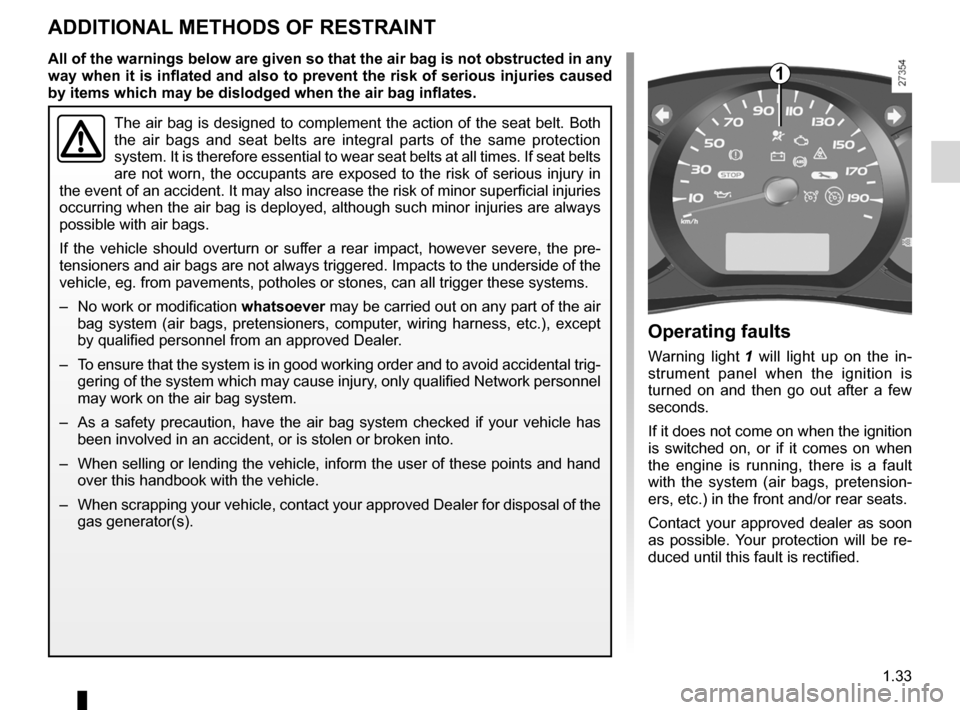
air bag................................................... (up to the end of the DU)
seat belts .............................................. (up to the end of the DU)
air bag ................................................... (up to the end of the DU)
additional methods of restraint ............. (up to the end of the DU)
methods of restraint in addition to the seat belts
(up to the end of the DU)
1.33
ENG_UD21591_2
Dispositifs de retenue complémentaires (X61 - F61 - K61 - Renault)
ENG_NU_813-11_FK61_Renault_1
Additional methods of restraint
The air bag is designed to complement the action of the seat belt. Both
the air bags and seat belts are integral parts of the same protection
system. It is therefore essential to wear seat belts at all times. If seat belts
are not worn, the occupants are exposed to the risk of serious injury in
the event of an accident. It may also increase the risk of minor superficial injuries
occurring when the air bag is deployed, although such minor injuries are always
possible with air bags.
If the vehicle should overturn or suffer a rear impact, however severe, the pre-
tensioners and air bags are not always triggered. Impacts to the underside of the
vehicle, eg. from pavements, potholes or stones, can all trigger these systems.
– No work or modification whatsoever may be carried out on any part of the air
bag system (air bags, pretensioners, computer, wiring harness, etc.), except
by qualified personnel from an approved Dealer.
– To ensure that the system is in good working order and to avoid accidental trig-
gering of the system which may cause injury, only qualified Network personnel
may work on the air bag system.
– As a safety precaution, have the air bag system checked if your vehicle has
been involved in an accident, or is stolen or broken into.
– When selling or lending the vehicle, inform the user of these points and hand
over this handbook with the vehicle.
– When scrapping your vehicle, contact your approved Dealer for disposal of the
gas generator(s).
ADDITIONAL MeTHODS OF ReSTRAINT
Operating faults
Warning light 1 will light up on the in -
strument panel when the ignition is
turned on and then go out after a few
seconds.
If it does not come on when the ignition
is switched on, or if it comes on when
the engine is running, there is a fault
with the system (air bags, pretension -
ers, etc.) in the front and/or rear seats.
Contact your approved dealer as soon
as possible. Your protection will be re-
duced until this fault is rectified.
1All of the warnings below are given so that the air bag is not obstructed in any
way when it is inflated and also to prevent the risk of serious injuries caused
by items which may be dislodged when the air bag inflates.
Page 59 of 237
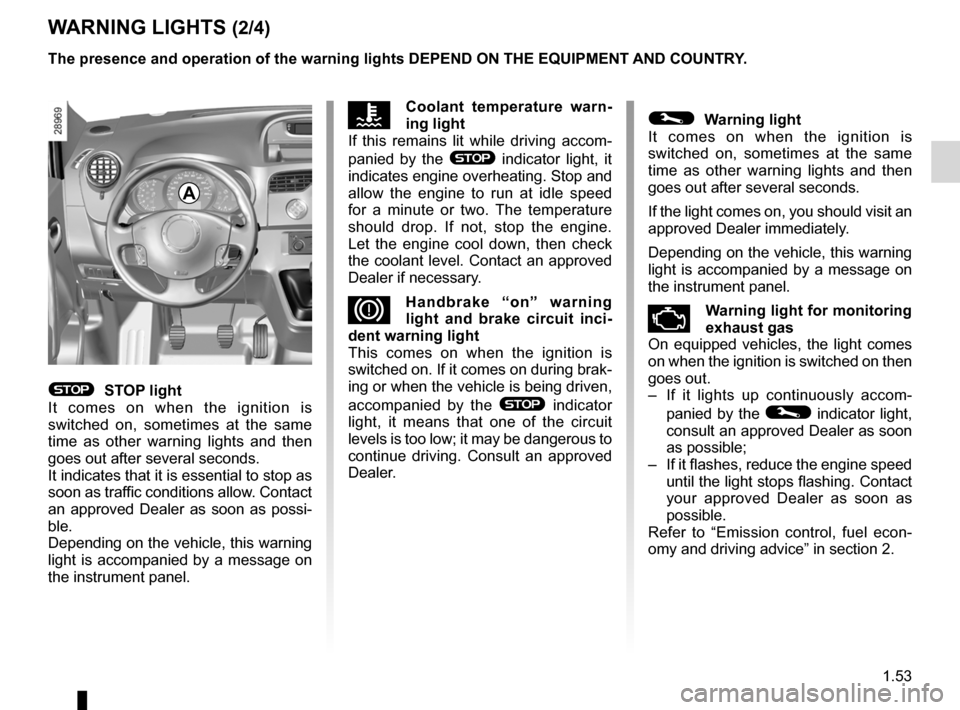
seat belts ............................................................... (current page)
handbrake .............................................................. (current page)
variable power-assisted steering ........................... (current page)
ABS ....................................................................... (current page)
JauneNoirNoir texte
1.53
ENG_UD24365_6
Tableau de bord : témoins lumineux (X61 - F61 - K61 - Renault)
ENG_NU_813-11_FK61_Renault_1
WARNING LIGHTS (2/4)
A
The presence and operation of the warning lights DepeND ON THe eQUIpMeNT AND COUNTR y.
© Warning light
It comes on when the ignition is
switched on, sometimes at the same
time as other warning lights and then
goes out after several seconds.
If the light comes on, you should visit an
approved Dealer immediately.
Depending on the vehicle, this warning
light is accompanied by a message on
the instrument panel.
\fWarning light for monitoring
exhaust gas
On equipped vehicles, the light comes
on when the ignition is switched on then
goes out.
– If it lights up continuously accom -
panied by the
© indicator light,
consult an approved Dealer as soon
as possible;
– If it flashes, reduce the engine speed
until the light stops flashing. Contact
your approved Dealer as soon as
possible.
Refer to “Emission control, fuel econ -
omy and driving advice” in section 2.
ÔCoolant temperature warn -
ing light
If this remains lit while driving accom -
panied by the
® indicator light, it
indicates engine overheating. Stop and
allow the engine to run at idle speed
for a minute or two. The temperature
should drop. If not, stop the engine.
Let the engine cool down, then check
the coolant level. Contact an approved
Dealer if necessary.
DHandbrake “on” warning
light and brake circuit inci -
dent warning light
This comes on when the ignition is
switched on. If it comes on during brak-
ing or when the vehicle is being driven,
accompanied by the
® indicator
light, it means that one of the circuit
levels is too low; it may be dangerous to
continue driving. Consult an approved
Dealer.® STOp light
It comes on when the ignition is
switched on, sometimes at the same
time as other warning lights and then
goes out after several seconds.
It indicates that it is essential to stop as
soon as traffic conditions allow. Contact
an approved Dealer as soon as possi-
ble.
Depending on the vehicle, this warning
light is accompanied by a message on
the instrument panel.
Page 60 of 237
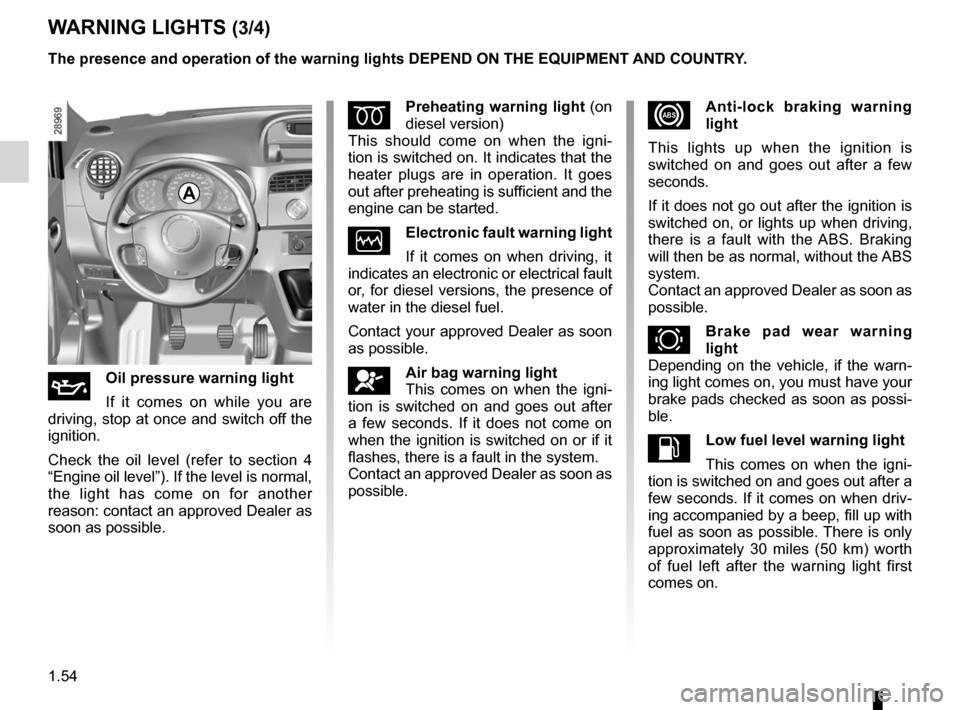
engine oil ............................................................... (current page)
battery .................................................................... (current page)
speed limiter .......................................................... (current page)
cruise control ......................................................... (current page)
ASR (traction control) ............................................ (current page)
filter particle filter ..................................................... (current page)
ESP: Electronic Stability Program ........ (up to the end of the DU)
1.54
ENG_UD24365_6
Tableau de bord : témoins lumineux (X61 - F61 - K61 - Renault)
ENG_NU_813-11_FK61_Renault_1
Jaune NoirNoir texte
WARNING LIGHTS (3/4)
A
The presence and operation of the warning lights DepeND ON THe eQUIpMeNT AND COUNTR y.
xAnti-lock braking warning
light
This lights up when the ignition is
switched on and goes out after a few
seconds.
If it does not go out after the ignition is
switched on, or lights up when driving,
there is a fault with the ABS. Braking
will then be as normal, without the ABS
system.
Contact an approved Dealer as soon as
possible.
\b Brake pad wear warning
light
Depending on the vehicle, if the warn-
ing light comes on, you must have your
brake pads checked as soon as possi-
ble.
LLow fuel level warning light
This comes on when the igni -
tion is switched on and goes out after a
few seconds. If it comes on when driv-
ing accompanied by a beep, fill up with
fuel as soon as possible. There is only
approximately 30 miles (50 km) worth
of fuel left after the warning light first
comes on.
Épreheating warning light (on
diesel version)
This should come on when the igni -
tion is switched on. It indicates that the
heater plugs are in operation. It goes
out after preheating is sufficient and the
engine can be started.
Òelectronic fault warning light
If it comes on when driving, it
indicates an electronic or electrical fault
or, for diesel versions, the presence of
water in the diesel fuel.
Contact your approved Dealer as soon
as possible.
åAir bag warning light
This comes on when the igni -
tion is switched on and goes out after
a few seconds. If it does not come on
when the ignition is switched on or if it
flashes, there is a fault in the system.
Contact an approved Dealer as soon as
possible.
ÀOil pressure warning light
If it comes on while you are
driving, stop at once and switch off the
ignition.
Check the oil level (refer to section 4
“Engine oil level”). If the level is normal,
the light has come on for another
reason: contact an approved Dealer as
soon as possible.
Page 76 of 237
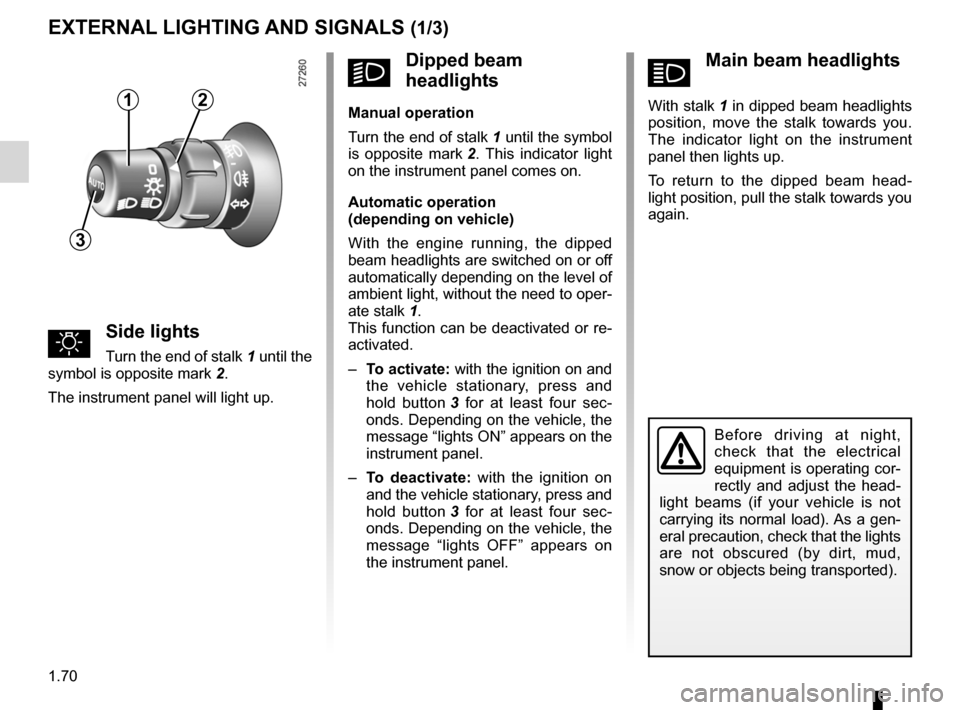
signals and lights .................................. (up to the end of the DU)
lights: side lights ......................................................... (current page)
lights: dipped beam headlights ................................... (current page)
lights: main beam headlights ...................................... (current page)
1.70
ENG_UD3885_1
Eclairage et signalisation extérieure (X61 - F61 - K61 - Renault)
ENG_NU_813-11_FK61_Renault_1
Jaune NoirNoir texte
áMain beam headlights
With stalk 1 in dipped beam headlights
position, move the stalk towards you.
The indicator light on the instrument
panel then lights up.
To return to the dipped beam head -
light position, pull the stalk towards you
again.
Éclairage et signalisation extérieure
uSide lights
Turn the end of stalk 1 until the
symbol is opposite mark 2.
The instrument panel will light up.
eXTeRNAL LIGHTING AND SIGNALS (1/3)
Before driving at night,
check that the electrical
equipment is operating cor-
rectly and adjust the head -
light beams (if your vehicle is not
carrying its normal load). As a gen-
eral precaution, check that the lights
are not obscured (by dirt, mud,
snow or objects being transported).
kDipped beam
headlights
Manual operation
Turn the end of stalk 1 until the symbol
is opposite mark 2 . This indicator light
on the instrument panel comes on.
Automatic operation
(depending on vehicle)
With the engine running, the dipped
beam headlights are switched on or off
automatically depending on the level of
ambient light, without the need to oper-
ate stalk 1.
This function can be deactivated or re-
activated.
– To activate: with the ignition on and
the vehicle stationary, press and
hold button 3 for at least four sec -
onds. Depending on the vehicle, the
message “lights ON” appears on the
instrument panel.
– To deactivate: with the ignition on
and the vehicle stationary, press and
hold button 3 for at least four sec -
onds. Depending on the vehicle, the
message “lights OFF” appears on
the instrument panel.12
3
Page 97 of 237
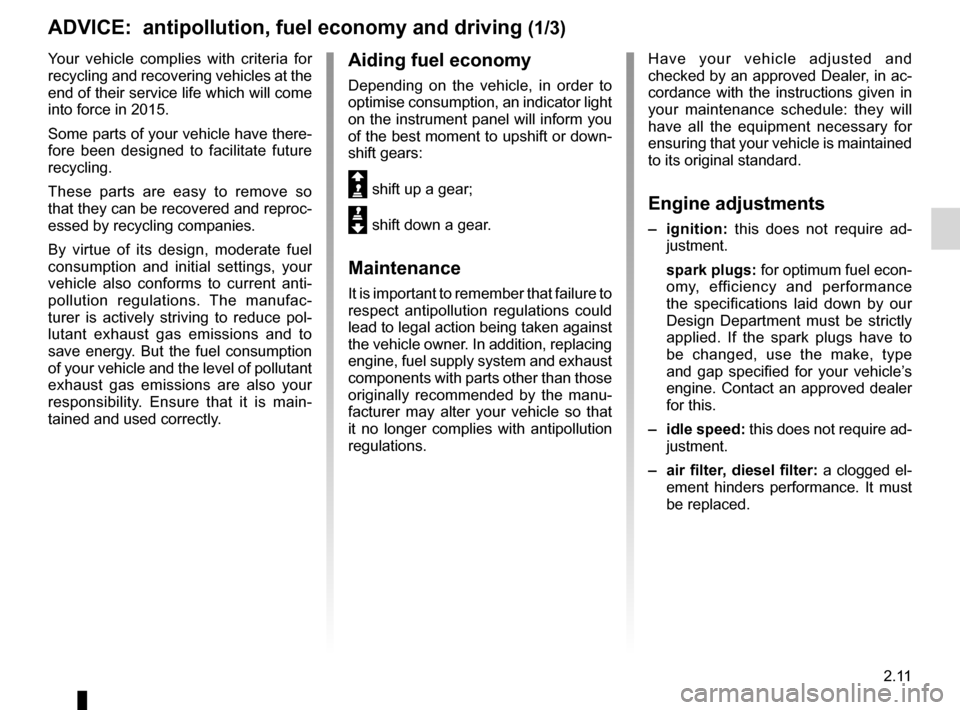
antipollutionadvice ............................................. (up to the end of the DU)
fuel advice on fuel economy .................. (up to the end of the DU)
fuel economy ........................................ (up to the end of the DU)
2.11
ENG_UD21480_4
Conseils : antipollution, économies de carburant, conduite (X83 - X61 - Renault)
ENG_NU_813-11_FK61_Renault_2
Advice on antipollution, fuel economy and driving
ADVICE: antipollution, fuel economy and driving (1/3)
Your vehicle complies with criteria for
recycling and recovering vehicles at the
end of their service life which will come
into force in 2015.
Some parts of your vehicle have there-
fore been designed to facilitate future
recycling.
These parts are easy to remove so
that they can be recovered and reproc-
essed by recycling companies.
By virtue of its design, moderate fuel
consumption and initial settings, your
vehicle also conforms to current anti-
pollution regulations. The manufac -
turer is actively striving to reduce pol -
lutant exhaust gas emissions and to
save energy. But the fuel consumption
of your vehicle and the level of pollutant
exhaust gas emissions are also your
responsibility. Ensure that it is main -
tained and used correctly. Have your vehicle adjusted and
checked by an approved Dealer, in ac-
cordance with the instructions given in
your maintenance schedule: they will
have all the equipment necessary for
ensuring that your vehicle is maintained
to its original standard.
Engine adjustments
–
ignition: this does not require ad -
justment.
spark plugs: for optimum fuel econ-
omy, efficiency and performance
the specifications laid down by our
Design Department must be strictly
applied. If the spark plugs have to
be changed, use the make, type
and gap specified for your vehicle’s
engine. Contact an approved dealer
for this.
– idle speed: this does not require ad-
justment.
– air filter, diesel filter: a clogged el-
ement hinders performance. It must
be replaced.
Aiding fuel economy
Depending on the vehicle, in order to
optimise consumption, an indicator light
on the instrument panel will inform you
of the best moment to upshift or down -
shift gears:
Š shift up a gear;
‰ shift down a gear.
Maintenance
It is important to remember that failure to
respect antipollution regulations could
lead to legal action being taken against
the vehicle owner. In addition, replacing
engine, fuel supply system and exhaust
components with parts other than those
originally recommended by the manu -
facturer may alter your vehicle so that
it no longer complies with antipollution
regulations.
Page 98 of 237
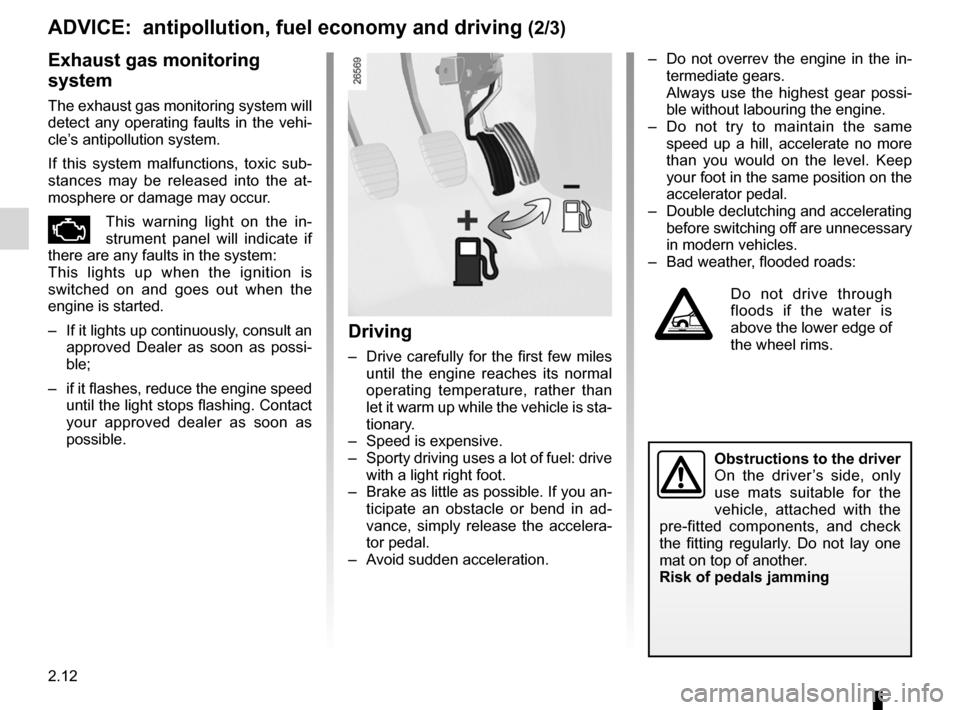
2.12
ENG_UD21480_4
Conseils : antipollution, économies de carburant, conduite (X83 - X61 - Renault)
ENG_NU_813-11_FK61_Renault_2
Jaune NoirNoir texte
ADVICE: antipollution, fuel economy and driving (2/3)
– Do not overrev the engine in the in-
termediate gears.
Always use the highest gear possi -
ble without labouring the engine.
– Do not try to maintain the same
speed up a hill, accelerate no more
than you would on the level. Keep
your foot in the same position on the
accelerator pedal.
– Double declutching and accelerating
before switching off are unnecessary
in modern vehicles.
– Bad weather, flooded roads:
Do not drive through
floods if the water is
above the lower edge of
the wheel rims.
Exhaust gas monitoring
system
The exhaust gas monitoring system will
detect any operating faults in the vehi-
cle’s antipollution system.
If this system malfunctions, toxic sub -
stances may be released into the at -
mosphere or damage may occur.
ÄThis warning light on the in -
strument panel will indicate if
there are any faults in the system:
This lights up when the ignition is
switched on and goes out when the
engine is started.
– If it lights up continuously, consult an
approved Dealer as soon as possi -
ble;
– if it flashes, reduce the engine speed
until the light stops flashing. Contact
your approved dealer as soon as
possible.
Driving
– Drive carefully for the first few miles
until the engine reaches its normal
operating temperature, rather than
let it warm up while the vehicle is sta-
tionary.
– Speed is expensive.
– Sporty driving uses a lot of fuel: drive
with a light right foot.
– Brake as little as possible. If you an-
ticipate an obstacle or bend in ad -
vance, simply release the accelera -
tor pedal.
– Avoid sudden acceleration.
Obstructions to the driver
On the driver ’s side, only
use mats suitable for the
vehicle, attached with the
pre-fitted components, and check
the fitting regularly. Do not lay one
mat on top of another.
Risk of pedals jamming
Page 102 of 237
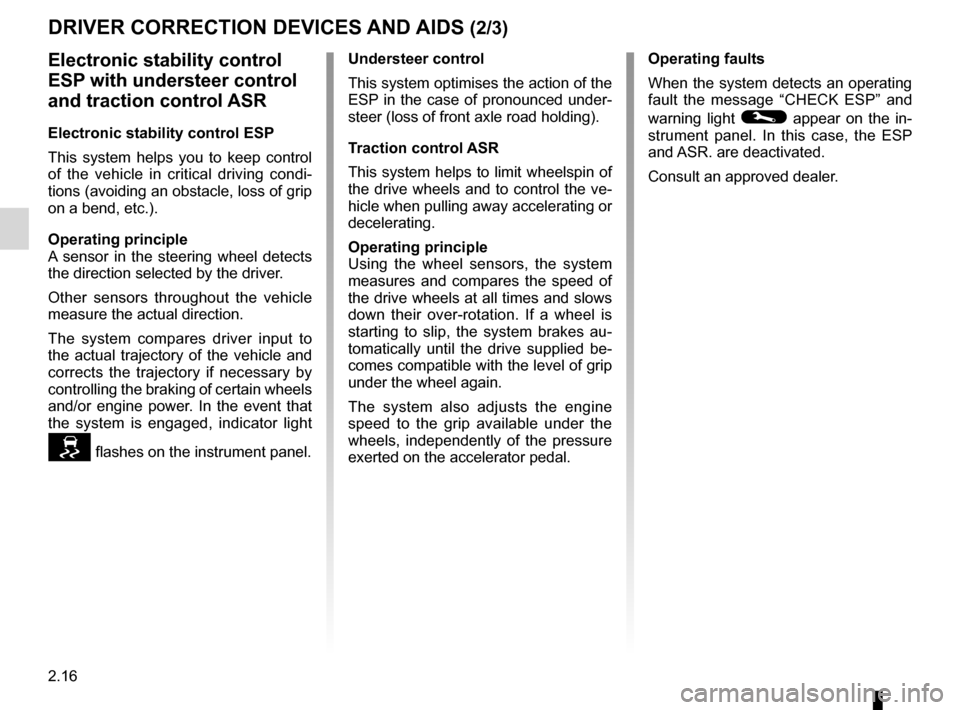
2.16
ENG_UD29758_3
Dispositifs de correction de conduite (X61 - F61 - K61 - Renault)
ENG_NU_813-11_FK61_Renault_2
Jaune NoirNoir texte
DRIVER CORRECTION DEVICES AND AIDS (2/3)
Electronic stability control
ESP with understeer control
and traction control ASR
Electronic stability control ESP
This system helps you to keep control
of the vehicle in critical driving condi -
tions (avoiding an obstacle, loss of grip
on a bend, etc.).
Operating principle
A sensor in the steering wheel detects
the direction selected by the driver.
Other sensors throughout the vehicle
measure the actual direction.
The system compares driver input to
the actual trajectory of the vehicle and
corrects the trajectory if necessary by
controlling the braking of certain wheels
and/or engine power. In the event that
the system is engaged, indicator light
flashes on the instrument panel. Understeer control
This system optimises the action of the
ESP in the case of pronounced under
-
steer (loss of front axle road holding).
Traction control ASR
This system helps to limit wheelspin of
the drive wheels and to control the ve-
hicle when pulling away accelerating or
decelerating.
Operating principle
Using the wheel sensors, the system
measures and compares the speed of
the drive wheels at all times and slows
down their over-rotation. If a wheel is
starting to slip, the system brakes au -
tomatically until the drive supplied be -
comes compatible with the level of grip
under the wheel again.
The system also adjusts the engine
speed to the grip available under the
wheels, independently of the pressure
exerted on the accelerator pedal. Operating faults
When the system detects an operating
fault the message “
CHECK ESP” and
warning light
© appear on the in-
strument panel. In this case, the ESP
and ASR. are deactivated.
Consult an approved dealer.